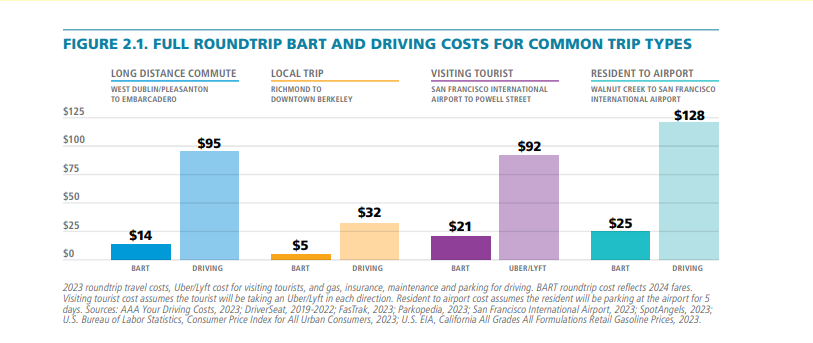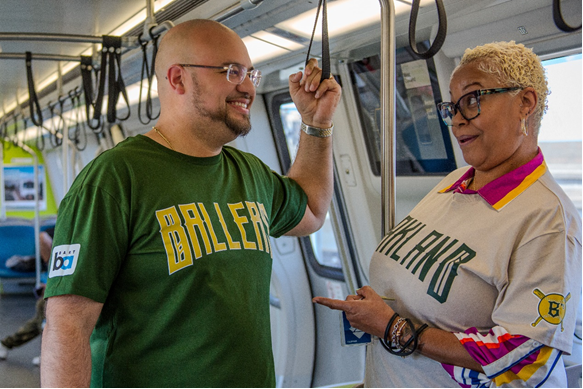Search Results
BART Interim Police Chief ends temporary ban on Taser use
BART Police officers are now once again allowed to carry Tasers if they so choose. All 196 officers have completed the required updated training on when to use their Tasers and where to holster them. On April 15, BART Interim Chief of Police Daschel Butler temporarily suspended the Taser program for two
BART Police Chief Kenton Rainey's column on moving the community forward
Last year, President Obama called upon the nation to take a hard look at how police officers interact with and support their local communities, inviting experts and leaders from Maine to California to submit best practices on growing community trust and public understanding. This initiative, the President’s
Take the survey: BART invites feedback on Downtown Berkeley Station modernization
Take the Survey. It is open through October 5. Downtown Berkeley Station is in the queue to get a makeover. Last year BART invited visioning feedback on its modernization plans for the station and received over 1,000 responses from the public. These suggestions helped BART planners develop a phased
BART Police release name of officer, announce change to search policy
At the request of the officer, BART Police Chief Kenton Rainey today released the name of the officer who fired the fatal shot in last Tuesday’s tragic death of Sgt. Tommy Smith. Detective Michael Maes has requested that his role in the tragedy be made public in the interest of transparency. Detective Maes is
BART to run on Saturday schedule for Martin Luther King Jr. holiday
BART will operate on a Saturday schedule with service beginning at 6 am on Monday, January 21, for the Martin Luther King Jr. holiday. To better serve customers who do not have the holiday off, BART will add extra trains to the schedule based on demand levels from previous years during the morning commute
BART Board gives green light to Concord Station plaza makeover
Using a mixture of local and state funding, the Board of Directors voted today to award a $3.2 million contract to give the Concord Station plaza a major makeover. The transformation will include improved pedestrian access with a decorative crosswalk, an added bike lane, modern, energy-efficient lighting and
Role in the Region: BART lowers the cost of living in the Bay Area

In July, BART released the Role in the Region Report, a comprehensive study of BART's impact on the Bay Area illustrated by new analyses, data visualizations, and powerful personal narratives. Over the coming months, we'll be sharing some of the key insights from the report in a series of articles here on bart.gov. Click here to read the first story — on BART's role in reducing regional traffic — and the here for the second story, which explores BART's contributions to the economy.
We encourage you to read the full report - click here - and visit the project webpage at bart.gov/roleintheregion.
Today's post looks at BART's impact on lowering the cost of living. See the full report for methodology.
BART helps riders save money
BART helps people get by in the Bay Area by connecting them to jobs and helping them save money on transportation costs.
BART trips are cheaper than driving, and people who live near BART stations typically have lower transportation costs than those in other parts of the region.

Figure 2.1 shows that the cost of taking BART is lower than driving for many common trip types. Households within a half-mile of a BART station have, on average, 30 percent fewer vehicles than households beyond a half-mile from a BART station. Annually, these households drive 16 percent fewer miles, which translates to lower transportation costs.
What BART Riders Say…
“I'd have much less money and a lot more stress due to needing a car to get around. I also would love San Francisco less if it didn't have BART. It's too important to the vitality of this city.- Rider based in San Francisco
BART connects workers to jobs
Within San Francisco, Contra Costa, and Alameda counties, census tracts within a half-mile of a BART station have a 13 percent higher average job access score, which considers the number, overall mix, and types of jobs. People who live in census tracts within a half-mile of a BART station commute, on average, 16 percent fewer minutes than people who live further away.
BART Yellow and Orange lines serve a high proportion of people without a college degree. A clear example of the access and benefit that BART provides is seen in the cities of Antioch and Pittsburg, which are both lower-income and more diverse than the Bay Area as a whole. Residents of these cities can use BART to reach jobs in larger Bay Area cities like San Francisco and Oakland in an affordable and timely manner.
What BART Riders Say…
“I don’t think my family and I could remain in the Bay Area without BART.”
Peter Woods, Brentwood, CA
With some 794,000 jobs (21% of the region's total) within a 15-minute walk of a BART station, BART helps people access a large pool of economic opportunities across the Bay Area. By linking people to jobs, BART helps put money in people's pockets, which increases their ability to thrive in the expensive region.
Rider story: Kassandra

In August, Kassandra Santillan started her second year at San Francisco State University, her dream college where she studies microbiology, her dream major. If she couldn’t take BART to school, she wouldn’t be able to attend.
“BART made it happen for me,” she said. “I can’t afford to live near campus, so I’d probably be at a community college instead.”
Santillan is the first person in her immediate family to attend college. She’s always aspired to study at SFSU because that's where her aunt went, and her aunt was one of the only people she knew who graduated from college.
Santillan lives in East Oakland, where she grew up. She doesn’t currently have access to a car, so she takes BART twice a day, five days a week to school. Before starting at SFSU, she’d never really used the system.
“We didn’t travel far away when I was young,” she said. “The only other time I’d use BART was for field trips to San Francisco."
Read Kassandra's story.
BART helps connect homeless Vietnam veteran to a home of his own
By MELISSA JORDAN BART Senior Web Producer If you've walked through Montgomery Station in the past five years, you might have noticed Jack Hanna. Or not. The wiry, wary Vietnam veteran may have seemed invisible in the rush of commuters grabbing coffee from the Peet’s stand in the morning, choosing a bouquet
Ticket Exchange Window to reopen Dec. 1 in Downtown Berkeley BART Station
On December 1, 2010, BART will reopen the Ticket Exchange Window in its new location in the Downtown Berkeley BART Station. The window has been relocated to a former bike locker location at the far end of the station (past the original location). Hours of operation are as before: Wednesdays from 10 am to 1:30
Join the Oakland Ballers for BART Night on Wednesday, Aug. 14

Step up to the plate, BART x baseball fans! BART has teamed up with the Oakland Ballers for a memorable game on Wednesday, August 14, starting at 6:35pm, at Raimondi Park (1800 Wood St, Oakland). Buy your tickets here.
It's BART Night, Bay Area!
On this special evening, we want to celebrate the role public transportation plays in making sure fans can get out and watch their favorite teams play. BART and organizations like the Ballers are natural partners – BART helps you get there, and the Ballers give you a place to go. Take me out to the BART game!
Some of the activities planned for BART Night include:
- An appearance by the BARTmobile
- BART employees’ children serving as ball kids
- Special BART guests throwing out the first pitch and taking the first at-bat
- BART Police Honor Guard posting the colors
- BART Police Lieutenant Joshua Perez singing the National Anthem
- Lots of BART staff in the stands going wild for the Ballers!

And let’s not forget the t-shirts. The Ballers, BART, and Oaklandish have collaborated to create two collectible “shirseys,” AKA a t-shirt mimicking the players’ jerseys. The tees, modeled above, feature the BART logo on the sleeve and the number 72 on the back, celebrating the year BART opened. Get yours on Railgoods.com.
The Oakland Ballers are a Pioneer League baseball team that plays at the historic Raimondi Park in West Oakland. Celebrating their inaugural season in 2024, the team is a BART partner and plays in uniforms with a BART patch on the right sleeve.
Get to the game by following the rider guide below and find more detailed directions here.
